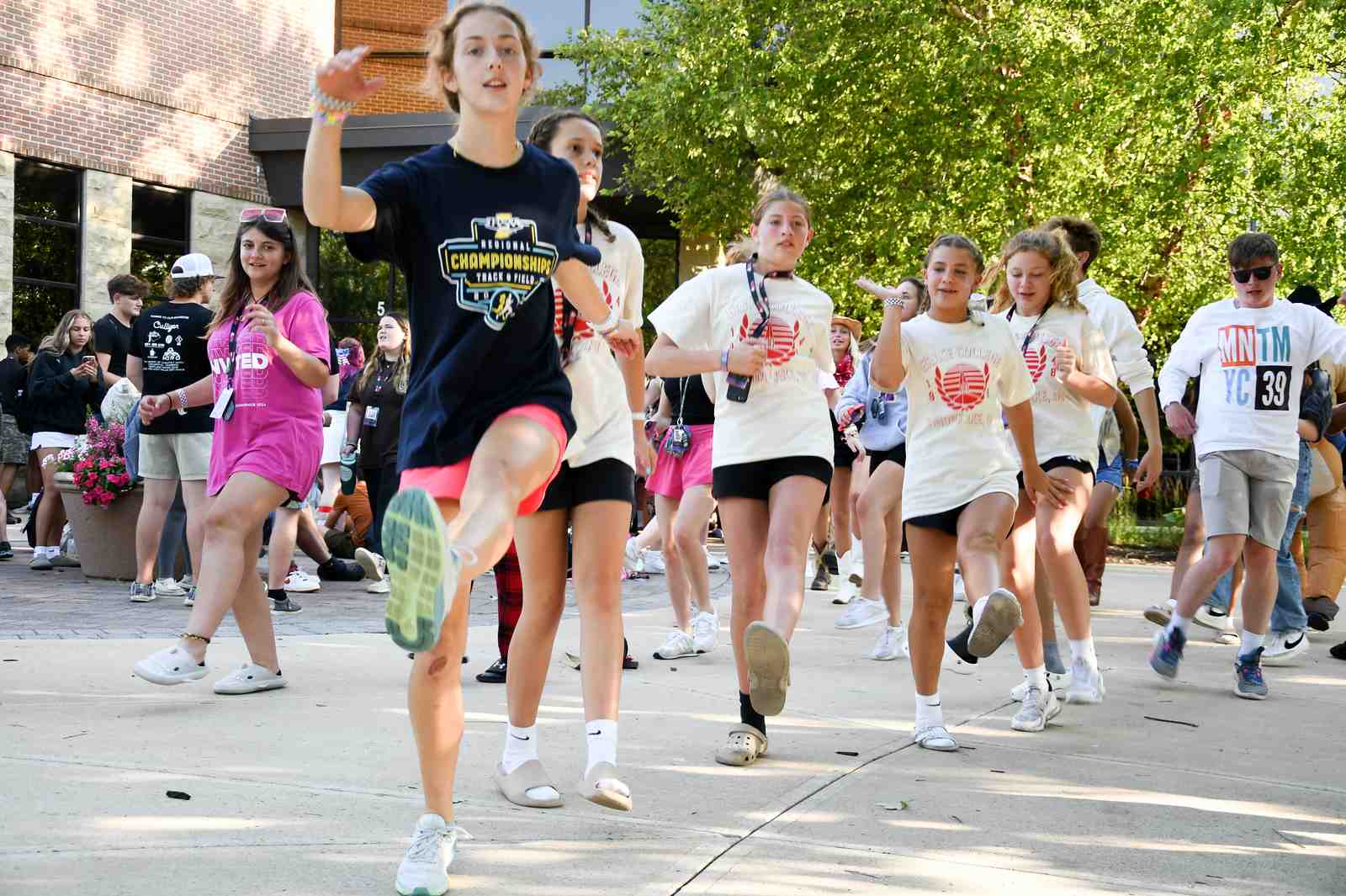Why Youth Group Games Are Essential for Ministry Success
Youth group games are more than time-fillers. These interactive activities break down social barriers, spark laughter, and give teens a tangible taste of biblical community. Research—even studies cited by the American Academy of Pediatrics—shows that active play cements learning far better than passive listening, so the fun you plan today can help truth stick tomorrow.
Below are four proven categories every leader should keep in their ministry toolbox:
Quick Icebreakers
- Change Places If
- Boppity Bop Bop
- Two Truths and a Lie
High-Energy Indoor Games
- Human Knot
- Minute to Win It
- Crab Soccer
Epic Outdoor Games
- Giants, Wizards, and Elves
- Spud
- Capture the Flag
Connection-Building Activities
- The Five H’s
- Electric Fence
Every youth leader knows the sinking feeling of having fifteen unplanned minutes and a room full of restless teenagers. The right game turns that anxiety into momentum, helping shy freshmen talk to confident seniors and changing a collection of individuals into a team. After three decades in ministry, I’ve watched these moments become launchpads for lifelong faith.

More Than Just Fun: The Purpose Behind the Play
Here’s the truth that every seasoned youth leader finds: youth group games aren’t just about keeping teenagers busy. They’re one of the most powerful ministry tools in your toolkit, and the research backs this up completely.
Think about it this way – when was the last time you saw a shy freshman naturally strike up a conversation with a confident senior during a Bible study? Now picture them working together to solve the Electric Fence challenge, laughing as they figure out how to get their whole team over that imaginary barrier. Suddenly, they’re not just two kids from different social circles – they’re teammates who’ve shared a victory.
That’s the magic of intentional play. Games build relationships in ways that traditional teaching methods simply can’t match. When students are focused on having fun together, their walls come down naturally. The class clown stops performing and starts genuinely connecting. The quiet kid finds their voice when they’re strategizing for Capture the Flag.
Trust develops through shared experiences – both the successes and the spectacular failures. There’s something beautiful about watching a group of teenagers who barely knew each other’s names suddenly become a team that celebrates together and encourages each other when things don’t go as planned. This emotional safety net becomes the foundation for those vulnerable conversations where real spiritual growth happens.
Here’s what’s really exciting: active learning through play helps students retain spiritual lessons far longer than passive listening ever could. When you tie a teamwork game to a lesson about the body of Christ, students don’t just hear the truth – they experience it in their muscles and their emotions. They feel what happens when everyone works together versus when someone decides to go rogue.
Games also create natural opportunities for leadership development. We’ve seen quiet students emerge as strategic thinkers, natural encouragers find their voice, and unlikely leaders step up when their team needs them most. These moments of findy often become turning points in a student’s spiritual journey.
And let’s not forget the memory-making power of games. Students might forget the three points of your sermon next week, but they’ll remember the epic sudden-death overtime victory in Spud for years to come. These positive memories become emotional anchors that keep students connected to your ministry even during the tough seasons of adolescence.
Learn more about building community and getting youth talking
How to Choose the Perfect Game for Your Group
Choosing the right youth group games can make the difference between a night students remember fondly and one they’d rather forget. After years of watching games succeed and fail, I’ve learned that intentional selection matters far more than having the flashiest activity.
Group size is your first consideration. When you’re working with a cozy group of 6-12 students, intimate activities like The Five H’s or circle games work beautifully because everyone stays engaged. But try those same games with 30 teenagers, and you’ll lose half of them to side conversations. Large groups need high-energy activities like Giants, Wizards, and Elves that can handle crowds while keeping everyone involved.
The age gap between middle school and high school students is wider than the Grand Canyon when it comes to game preferences. Seventh graders will enthusiastically play Boppity Bop Bop and think it’s hilarious, while eleventh graders might roll their eyes at the same activity. High schoolers prefer games with more strategy and social interaction, while middle schoolers just want to move and laugh.
Indoor versus outdoor settings completely change your game plan. Indoor spaces limit your options – you need to consider ceiling height, noise levels, and furniture placement. Outdoor games can accept running, shouting, and larger movements, but always have backup indoor options ready. Weather changes faster than teenage moods, and nothing kills momentum like scrambling for a Plan B.
Reading your group’s energy level is crucial for maintaining engagement. If students arrive hyped up from school or a big event, start with high-energy games to channel that excitement productively. When they’re dragging after a long day, gentle icebreakers help them transition into more active participation.
No-prep games become your secret weapon when plans fall through or time runs short. Activities like Rock Paper Scissors Tournament or Two Truths and a Lie require zero materials and minimal setup. Every youth leader needs a mental arsenal of these time-savers.
Don’t let limited resource availability discourage you from planning great games. Some of our most successful activities use nothing more than chairs, paper, or a playground ball. Creativity matters more than expensive equipment when building meaningful experiences.
Safety considerations must be non-negotiable. Establish clear boundaries before starting any game, scan for potential hazards, and modify contact games when you have mixed age groups. The goal is fun memories, not emergency room visits.
Find strategies for keeping youth engaged
| Game Category | Ideal Group Size | Energy Level | Prep Time | Best For |
|---|---|---|---|---|
| Icebreaker | 8-30 | Low-Medium | 0-5 minutes | New groups, program starts |
| Indoor | 10-25 | Medium-High | 5-15 minutes | Weather backup, limited space |
| Outdoor | 15-50 | High | 10-30 minutes | Nice weather, large groups |
| Team-Builder | 12-40 | Medium | 15-45 minutes | Retreats, leadership development |
The Ultimate List of Awesome Youth Group Games
The following games have been tested in real youth ministry settings and proven to engage students consistently. We’ve organized them by category to help you find the perfect fit for any situation.
Before diving into specific games, remember these success tips:
- Explain rules clearly and demonstrate when possible
- Be an enthusiastic host – your energy sets the tone
- Have backup plans ready for games that flop
- Adapt rules on the fly to keep things fun
- Focus on participation over perfection
Quick Icebreakers to Get Everyone Talking
Icebreakers serve as the bridge between arrival chaos and meaningful connection. These games work best at the beginning of programs when students are still settling in and need help transitioning from their outside world to youth group community.
Explore more icebreaker strategies
Change Places If
This classic game gets students moving while revealing commonalities they might never have found otherwise. Set up chairs in a circle with one fewer chair than participants. The person in the middle calls out “Change places if you…” followed by any true statement about themselves. Everyone who shares that trait must find a new seat while the middle person tries to claim a chair.
Materials needed: Chairs (one fewer than participants)
The beauty of this game lies in the statements students choose. Start with safe options like “Change places if you’re wearing sneakers” and watch as students get more creative with “Change places if you’ve ever cried during a Disney movie.” The laughter that erupts when half the group scrambles for seats creates instant bonding.
Debrief idea: After playing, ask students to share one surprising thing they learned about someone else. This transitions naturally into discussions about how God creates us with both unique gifts and shared experiences.
Boppity Bop Bop
This circle game tests reflexes and guarantees laughter. Students stand in a circle with one person in the middle. The middle person points to someone and says either “Boppity Bop Bop” or just “Bop.” If they say “Boppity Bop Bop,” the pointed-to person must say “Bop” before the middle person finishes the phrase. If they say “Bop,” the person must stay silent. Anyone who messes up becomes the new middle person.
Materials needed: None
The rhythm and pressure create hilarious moments when students inevitably mess up. The game moves quickly enough that even mistakes feel fun rather than embarrassing. We’ve seen the most reserved students crack up when they accidentally shout “Bop” at the wrong time.
Two Truths and a Lie
This classic getting-to-know-you activity works with any group size and requires zero materials. Each person shares three statements about themselves – two true, one false. The group tries to identify the lie. The key is encouraging creative truths that sound unbelievable and believable lies that could be true.
Variations: Speed round where each person gets only 30 seconds, or themed versions like “Two Truths and a Lie about Summer Vacation.” For larger groups, break into smaller circles to ensure everyone gets a turn.
High-Energy Indoor Youth Group Games

Indoor games need to maximize energy while respecting space limitations. These activities work well in fellowship halls, classrooms, or any indoor space where students can move around safely.
Human Knot
This teamwork challenge requires no materials but delivers powerful lessons about cooperation and persistence. Students stand in a circle, reach across to grab hands with two different people (not next to them), then work together to untangle themselves without letting go.
How to play: Form circles of 6-10 people. Everyone reaches across to grab hands with two different people. The resulting “knot” must be untangled through stepping over, under, and around each other while maintaining hand contact. Some groups end up in one large circle, others in smaller connected circles.
Teamwork lesson: This game perfectly illustrates how individual actions affect the whole group. Students quickly learn that forcing solutions creates more problems, while patient communication leads to breakthrough moments.
Debrief questions: “When did you feel frustrated? How did the group work through challenges? What role did communication play? How does this relate to functioning as the body of Christ?”
Minute to Win It
These quick skill-based challenges create excitement through time pressure and friendly competition. Set up multiple stations or run challenges sequentially with the whole group cheering for individual participants.
Challenge ideas:
- Stack 36 cups into a perfect triangle, then back into a single stack
- Move a cookie from forehead to mouth using only facial muscles
- Pop balloons by sitting on them (have extras ready)
- Build the tallest tower using only plastic cups and rubber bands
- Transfer cotton balls from one bowl to another while blindfolded
Materials needed: Varies by challenge (cups, cookies, balloons, cotton balls, blindfolds)
The beauty of Minute to Win It lies in its accessibility – everyone can participate regardless of athletic ability. The time pressure creates excitement, while the silly nature of challenges keeps competition light-hearted.
Crab Soccer
This modified soccer game requires players to move in crab position (sitting, hands behind for support, feet forward). Set up goals at opposite ends of your space and let teams try to score using only their feet.
Materials needed: Playground ball, cones or markers for goals
Safety tip: Ensure adequate space between walls and play area. Players tire quickly in crab position, so rotate frequently or play shorter rounds.
The awkward movement creates natural comedy while providing genuine physical challenge. Students who might feel intimidated by regular sports often excel at this modified version.
Epic Outdoor Youth Group Games
Giants, Wizards, and Elves
This large group strategy game combines elements of Rock Paper Scissors with team tactics. Divide into two teams that huddle to choose their identity: Giants (arms raised, roaring), Wizards (arms forward, casting spells), or Elves (crouched, hands to ears). Giants smash Wizards, Wizards zap Elves, and Elves bite Giants’ ankles.
How to play: Teams line up facing each other about 10 feet apart. On the count of three, both teams reveal their choice simultaneously. The winning team chases the losing team back to their safe zone, trying to tag runners before they reach safety. Tagged players join the other team.
Large group adaptation: With 30+ students, create multiple teams and run tournament-style brackets, or play with three teams where each chooses a different character.
Spud
This active throwing and dodging game works well with 10-30 students and requires only a soft ball. One player throws the ball high while calling out another player’s name. Everyone scatters except the named player, who must catch the ball and yell “Spud!” to freeze all other players.
Materials needed: Soft ball (foam or rubber playground ball)
Variations: Play with multiple balls for larger groups, or create themed versions where players must freeze in specific poses. For younger students, use larger, softer balls and shorter throwing distances.
The combination of strategy (where to run) and skill (catching and throwing) keeps everyone engaged. Students love the suspense of waiting to hear their name called.
Capture the Flag
This classic team-based territory game never gets old when run with clear rules and proper setup. Divide your area into two territories with a center line. Each team has a flag in their territory that the opposing team tries to capture and return to their own side.
Classic rules: Players tagged in enemy territory go to “jail” and can only be freed by teammates tagging them. The flag must be carried (not thrown) back to your territory to score. First team to capture the opposing flag wins.
Materials needed: Two flags (or bandanas), cones to mark boundaries, optional jail markers
Strategy tips: Encourage teams to develop roles – defenders, attackers, and rescue specialists. This creates natural leadership opportunities as students coordinate their efforts.
Learn more about building thriving youth communities
Games for Deeper Connection
The Five H’s
This isn’t technically a game but rather a structured sharing activity that builds deeper relationships faster than traditional icebreakers. Developed by camp professionals and refined over decades, it guides participants through five areas of personal sharing.
The Five H’s explained:
- Heritage: What type of family did you grow up in? What shaped your early years?
- Heroes: Who has impacted you in a significant way? What did they teach you?
- Heartaches: What experiences have broken your heart or caused you pain?
- Highlights: What achievements or moments in your life are you most proud of?
- Hopes: What dreams and aspirations do you have for your future?
Fostering vulnerability: The progression from lighter topics (Heritage) to deeper ones (Heartaches) creates natural intimacy. Students often share things they’ve never told anyone, creating bonds that last far beyond youth group.
Set time limits for each section (2-3 minutes per person per H) and remind participants that vulnerability is a gift, not a competition. The goal isn’t to have the most dramatic story but to be authentically known.
Electric Fence
This trust-building challenge requires teams to get every member over a rope “fence” without touching it. The physical problem-solving creates natural opportunities for leadership and cooperation.
How to play: Tie a rope between two trees or posts at about waist height. The entire team must cross to the other side without anyone touching the rope. If someone touches it, the whole team starts over. Team members can lift, support, and help each other, but the rope remains electrified.
Trust building: Students must literally trust others to support their weight and guide them safely. Quiet students often emerge as strategic thinkers, while natural leaders learn to listen to others’ ideas.
Materials needed: Rope, two anchor points (trees, posts, or strong volunteers)
Debrief focus: “How did you feel trusting others to lift you? What happened when someone made a mistake? How did the team support each other? What does this teach us about Christian community?”

Frequently Asked Questions about Youth Group Games
How can I adapt a game for very small or very large groups?
Small groups (6–10 students) shine with activities that keep everyone constantly involved—think Mafia, Boppity Bop Bop, or a single-circle version of Human Knot. With 40+ teens, break into teams or run simultaneous stations. A quick bracket for Rock, Paper, Scissors or a three-team Giants, Wizards, and Elves keeps big crowds organized and engaged.
What are some no-prep games I can use in a pinch?
Keep these in your mental back pocket:
- Rock, Paper, Scissors Tournament
- Two Truths and a Lie
- Simon Says
- The “Huh?” Laugh-Challenge
- Would You Rather (students move to different sides of the room to vote)
All require zero supplies and can fill 5–15 minutes without feeling like filler.
How do I make sure games are inclusive for all students?
- Offer multiple roles (referee, scorekeeper, strategist) so participation isn’t limited to athletic ability.
- Favor non-elimination formats where “out” players switch roles instead of sitting on the sidelines.
- Check privately for physical or sensory needs and adapt equipment—larger balls, seated options, or communication-based tasks—so everyone contributes meaningfully.
- Model encouragement and shut down put-downs fast; culture flows from the leader.
With a little creativity and flexibility, games become a shared win where every teenager feels seen, valued, and eager to come back next week.
Conclusion
The journey through these youth group games brings us back to a fundamental truth: ministry happens best in relationship, and relationships form naturally when teenagers are laughing together. These aren’t just activities to fill time – they’re carefully chosen tools that transform a collection of awkward teenagers into a thriving community of young believers.
Every game we’ve shared has been battle-tested in real youth ministry settings. The shy freshman who found her voice during Two Truths and a Lie, the class clown who found leadership skills in Capture the Flag, the new student who felt welcomed through Change Places If – these moments happen because intentional leaders choose games that serve a purpose beyond entertainment.
The perfect game is the one that fits your group right now. A beautifully executed round of Human Knot with eight students often creates more lasting impact than a chaotic attempt at Giants, Wizards, and Elves with forty. Start where you are, with what you have, and let your confidence grow alongside your students’ community.
Be creative and make these games your own. The rules we’ve provided are launching points, not rigid requirements. Some of our most memorable ministry moments have emerged from spontaneous adaptations when a leader sensed what their group needed in that moment. Trust your instincts and adjust as you go.
Your enthusiasm makes all the difference. Students can instantly tell when you’re genuinely enjoying yourself versus just checking a box on your program plan. When you laugh at the ridiculous moments in Boppity Bop Bop, when you cheer for the underdog team in Spud, when you participate in the vulnerability of The Five H’s – you’re modeling the kind of authentic community you want them to experience.
At Momentum Ministry Partners, we’ve seen how the right youth group games create ripple effects that extend far beyond youth group walls. Students who learn to trust each other through Electric Fence become the adults who serve together in ministry. Teenagers who laugh together during Minute to Win It challenges become the young adults who support each other through life’s real challenges.
The teenagers in your ministry are searching for a place where they can be known, accepted, and challenged to grow. Games provide that space in ways that few other ministry approaches can match. They break down social barriers, create shared experiences, and build the emotional safety that makes spiritual conversations possible.
Your ministry matters, and the time you invest in building community through play will pay dividends for years to come. The students sitting in your youth room tonight need what you have to offer – not just the games themselves, but the love, intentionality, and care you bring to creating meaningful experiences.







0 Comments